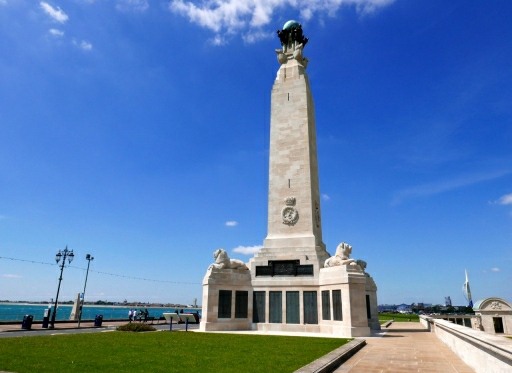There are numerous naval memorials to be found in parish churches and cathedrals all over the UK commemorating men and ships lost at sea in the eighteenth and nineteenth centuries. Some commemorate heroes such as Nelson and other senior officers, but never ordinary seamen. These men were either buried at sea or their bodies lost for ever in the stormy waters of the Atlantic and other oceans of the world. The families of these men had no grave to visit and nowhere to mourn.
All was to change at the end of the First World War when the newly created Imperial War Graves Commission decided that for the first time ever missing soldiers and men should be named on memorials to be built on the battlefields of France, Belgium, Gallipoli and other places. The Admiralty immediately insisted that naval men should have their own separate memorials.
All ships of the Royal Navy were attached to one of three ports - Portsmouth, Plymouth and Chatham - so it was decided to build memorials in each of these ports.
The Portsmouth Naval Memorial, in a prominent position on Southsea Front, names 9667 men listed by ship and in date order of sinking. Designed by Sir Robert Lorimer with sculptures by Henry Poole the memorial was unveiled by the Duke of York on 15 October 1924 who had himself been present at the Battle of Jutland.
The Chatham Memorial built on a hill overlooking the port commemorates 8516 men. It was unveiled by the Prince of Wales (the future King Edward VIII) on 26 April 1924 whilst the Plymouth Memorial commemorating 7753 men (including South African and Australian seamen) was unveiled by HRH Prince George on 29 July 1924.
Merchant Navy men had their own separate memorial at Tower Hill London beside the River Thames. 11977 names are recorded listed by ship. Designed by Sir Edwin Lutyens with sculptures by Sir William Read-Dicle it was unveiled by Queen Mary on 12 December 1928.
A fifth memorial can be found in Holly Brook Cemetery Southampton. This relates to Army men lost at sea in Home Waters like the English Channel, the Irish and North Seas. 1853 names are inscribed on wall panels. These include some 600 South Africans of the Lasons Corps lost when their troop ship (SS Mendi) was torpedoed off the Isle of Wight on 21 February 1917. Also inscribed is Lord Kitchener who was drowned off the Orkney Islands in June 1916 whilst on a secret mission to Russia. His ship HMS Hampshire struck a mine in very stormy seas and there were very few survivors. The memorial was unveiled by Sir William Robertson on 12 December 1930.
An anonymous poem, written by a merchant seaman, sums up the value of these memorials very well.
No cross marks the place where now we lie
What happened is known but to us
You asked and we gave our lives to protect
Our land from the enemy curse.
No Flanders Fields where poppies grow,
No Gleaming Crosses - row on row
No Unnamed Tomb for all to see
And pause - and wonder who we might be.
The Sailors Valhalla is where we lie
On the ocean bed watching ships pass by
Sailing in safety now thro the waves
Often right over our sea-locked graves.
We ask you just to remember us.





